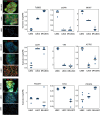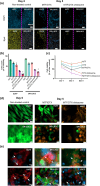Establishment of a chemoresistant laryngeal cancer cell model to study chemoresistance and chemosensitization responses via transcriptomic analysis and a tumor-on-a-chip platform
- PMID: 40385549
- PMCID: PMC12079406
- DOI: 10.1002/btm2.10741
Establishment of a chemoresistant laryngeal cancer cell model to study chemoresistance and chemosensitization responses via transcriptomic analysis and a tumor-on-a-chip platform
Abstract
Tumor resistance to chemotherapy is a common cause of cancer recurrence in patients with head and neck squamous cell carcinoma. The goal of this study is to establish and characterize a chemoresistant laryngeal cancer cell model and test its potential utility for chemosensitizing therapy. At the genotypic level, RNA sequencing confirmed that the cells acquired putative resistance with upregulated docetaxel-resistant (DR) genes (e.g., TUBB3, CYP24A1) and signaling pathways (e.g., PI3K/mTOR, autophagy). For phenotypic analysis, DR cells were co-cultured with laryngeal fibroblasts in a 2-channel microfluidic chip that mimics a hypoxic tumor core in vivo. A drug sensitivity test with a chemosensitizer, metformin (MTF), was performed on the laryngeal tumor-on-a-chip. Compared to non-treated controls, MTF-primed cancer cells exhibit higher sensitivity to docetaxel (DTX), that is, cell death. Collectively, this resistance-acquired cell model displayed presumed genotypic and phenotypic profiles of chemoresistance providing a viable option for testing new therapeutic strategies for restoring tumor sensitivity to DTX.
Keywords: chemoresistance; docetaxel; hypoxia; laryngeal cancer; metformin; senescence; transcriptomics; tumor‐on‐a‐chip.
© 2024 The Author(s). Bioengineering & Translational Medicine published by Wiley Periodicals LLC on behalf of American Institute of Chemical Engineers.
Conflict of interest statement
The authors declare no conflict of interest.
Figures







Similar articles
-
Exosomal miR-200c suppresses chemoresistance of docetaxel in tongue squamous cell carcinoma by suppressing TUBB3 and PPP2R1B.Aging (Albany NY). 2020 Apr 20;12(8):6756-6773. doi: 10.18632/aging.103036. Epub 2020 Apr 20. Aging (Albany NY). 2020. Retraction in: Aging (Albany NY). 2024 Oct 31;16(20):13174-13175. doi: 10.18632/aging.206148. PMID: 32310826 Free PMC article. Retracted.
-
circPARD3 drives malignant progression and chemoresistance of laryngeal squamous cell carcinoma by inhibiting autophagy through the PRKCI-Akt-mTOR pathway.Mol Cancer. 2020 Nov 24;19(1):166. doi: 10.1186/s12943-020-01279-2. Mol Cancer. 2020. PMID: 33234130 Free PMC article.
-
Identification of multidrug chemoresistant genes in head and neck squamous cell carcinoma cells.Mol Cancer. 2023 Sep 4;22(1):146. doi: 10.1186/s12943-023-01846-3. Mol Cancer. 2023. PMID: 37667354 Free PMC article.
-
Glucocorticoid Receptor Regulates and Interacts with LEDGF/p75 to Promote Docetaxel Resistance in Prostate Cancer Cells.Cells. 2023 Aug 11;12(16):2046. doi: 10.3390/cells12162046. Cells. 2023. PMID: 37626856 Free PMC article.
-
N6-methyladenosine-modified circQKI inhibits prostate cancer docetaxel-sensitivity via miR-188-3p/Beclin-1 pathway.Life Sci. 2025 Jul 1;372:123646. doi: 10.1016/j.lfs.2025.123646. Epub 2025 Apr 17. Life Sci. 2025. PMID: 40250752
References
LinkOut - more resources
Full Text Sources
Miscellaneous

